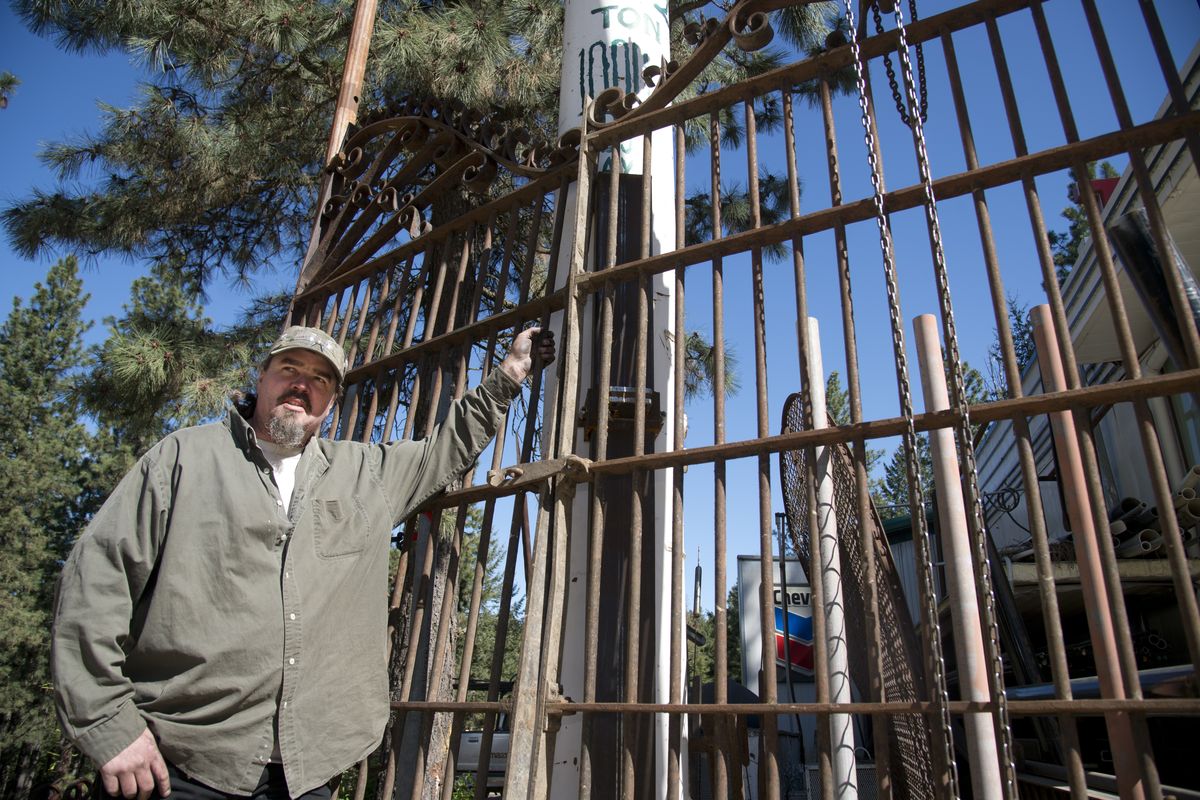Effort underway to restore jail’s ‘gallows gates’ at county courthouse

Sue Walker hopes the gates that once welcomed Spokane criminals to their jail cells – and two to their deaths – will return as a symbol on the county courthouse grounds.
“Let it be a life lesson,” she said.
The rusting iron gates discarded at Plantes Ferry Park following the demolition of the old county jail in 1970 are waiting to be restored in anticipation of returning them near where they stood for more than 70 years.
Walker, secretary and treasurer of the Spokane Law Enforcement Museum, and County Facilities Director Ron Oscarson are working to bring back the gates that once opened for police cruisers, and for two men hanged in the early days of Spokane County, to the yard north of the Spokane County Courthouse.
“We hope to get it as close as we can to the original site,” said Oscarson, who sought approval from Spokane County commissioners last month to pursue grants and other funding opportunities to reconfigure the yard and allow installation of the gates. A wheelchair accessibility ramp rises from the ground where the gates once stood, and moving that will be the costliest part of the project, Oscarson said. Discolored bricks on the outside of one of the courthouse’s signature turrets are a conspicuous reminder where the gate extended from the building, separating the freedom of the courthouse campus from the jail yard within.

Oscarson said he doesn’t know how the gates, now rusted with age and exposure to the sun and rain, wound up at the Spokane County Parks maintenance building at Plantes Ferry Park. Parks Superintendent Don Secor started with the county in 1974, and he heard stories from longtime employees about the gates that once stood at the county jail.
“They just sat out there, at our maintenance shop, for years and years and years,” Secor said.
He met Chuck King, son of the late Spokane police officer of the same name, at a yard sale in 2008 and told him about the gates at the park. King contacted Walker and set the wheels in motion for the Law Enforcement Museum to take possession of the gates. It was obvious the 11-foot-tall, wrought-iron structures, propped against a cyclone fence at Plantes Ferry, were the same that appeared in old photographs of the county jail.
The Parks Department loaned the gates to the museum in December 2008, and they were stored at a residence on the South Hill until they could be restored and returned to the courthouse courtyard.
Rick Nelson, who owns Ornamental Gate and Fence in Mead, agreed to restore the so-called “gallows gates” several months ago at the request of longtime friend King. The gates are sitting at his shop near Mt. Spokane High School, awaiting the final word about whether relocating them on the grounds will be feasible.
“We talked about different ways of restoring them, whether to leave them original, with this nice rust on it, or sandblast it and paint them,” he said. “It looks like the majority of people want them sandblasted and painted.”
Nelson, who is working to reconstruct an old mom and pop gas station in his shop, said he’d prefer leaving some of the rust to display the character of the wrought-iron fence. No welding is present on the gates, with pieces of iron held together by rivets – a sign of the gates’ late-19th-century construction.
“Actually, I’m a little bit nervous about it,” Nelson said. “To me, this is a huge part of our history here, and we can’t go and hack it up.”
Nelson’s colleague Dave Shoesmith will restore the gates.
King said he hopes the gates return to the ground where they originally stood. “It’s perfect. They just belong there.”
Oscarson said the most likely construction would set the gates off the building as a display visitors could see from all angles.
“It’s something that you could walk around, with bricks on both sides,” Oscarson said. The county already owns bricks, used to construct some walls on the courthouse campus, that could be used to construct the frame of the gate at minimal cost, Walker said.
Walker and the county will seek gifts from the public to make the return of the gates a reality, and she hopes to have a plaque containing some of the history of the gates built into the wall, as well as a plaque listing the names of donors. She also wants a phrase inscribed near the gate, warning passersby of the consequences of making poor decisions.
“Be careful of the choices you make in life, lest you enter these gates,” Walker hopes the plaque will read. “It’s never too late to turn around and go the other way!”
She said she’s aware there may be some backlash about putting on display gates that could be a symbol of capital punishment and a more stringent criminal justice system. But she hopes the gates will be a more positive symbol of the possibility of change and the history of the county.
“Should your kids be shielded from what our reality is?” Walker said. “Maybe this is the optimist in me, but I want people who come through here a lot, and decide to change, to have their picture taken next to that phrase, and be able to say, ‘I broke free.’ ”